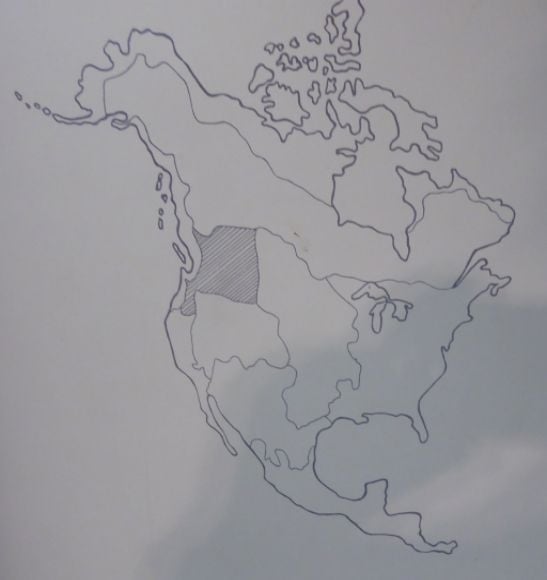Ancient America: Stone Architecture
( – promoted by navajo)
By the time the first Europeans were beginning to explore and establish colonies in the Americas, Europeans considered stone architecture, particularly the construction of monumental public buildings, to be the mark of civilization. Since Europeans generally did not consider the Indians in what is now the United States to be civilized, it was assumed that they didn’t use stone for building and that they did not create monumental public architecture. However, in many parts of North America, Indians had been building with stone for many centuries.
The most spectacular example of Native American stone architecture is found in the Southwest where the Anasazi-the ancestors of the modern Pueblos and thus more properly designated as Ancestral Puebloans-built large apartment complexes called Great Houses out of stone. These houses, which are often three and four stories in height, were carefully constructed out of dressed stone (stone which had been purposefully shaped for use in the construction). The stone for the Great Houses was often quarried some distance away and then transported by human carriers to the building site.

Building the Great Houses required a massive investment in labor-both skilled and unskilled. Once the stone was quarried, it was broken into thin, workable tablets by the masons. In laying the stones for form the walls, laborers had to haul baskets of wet mortar up on the wall. To form the ceiling and roofs, woodworkers had to fell trees and then shape the timbers to fit into the walls.
The stone work in the Great Houses was done in such a manner that the lines created by the stones were visually pleasing. The stones were laid so that they formed lines of uniform color and texture. The stone walls were then plastered over: beauty to the Anasazi was more than skin deep.
The Great Houses were often laid out in accordance with astronomical observations. Some are oriented toward the 18.6-year lunar standstill, while others are oriented toward the spring and fall equinoxes.
Pueblo Bonito, an Ancestral Puebloan Great House located in Chaco Canyon, New Mexico, was occupied from about 820 to 1150 CE. This is the largest of the Great Houses. This massive stone structure consists of about 650 rooms, 60 kivas (underground ceremonial centers), three great kivas, and two platform mounds. The shape and orientation of this structure serves to collect solar heat and make for a comfortable year-round residence. The curved walls of the pueblo open to the south and it is stepped so that the northern part of the building is four stories high while the southern part is only one story. This allows the sun’s energy to be reflected onto the central plaza.
Like the other Great Houses in Chaco Canyon, Pueblo Bonito was built from sandstone. In the older portions of the building, the Ancestral Puebloans used blocks of sandstone which covered the entire width of the wall. These stones were held in place with mortar. In later construction, the Anasazi built walls which contained a rubble-core which was faced on both sides with a veneer of neatly fitted sandstone blocks. The sandstones used in the construction were of uniform size and were hand smoothed.
The Great Houses had wooden roofs. The beams for the roofs were carefully fitted in the stone walls and were smoothed at the ends so that they did not protrude. The poles for the beams were premeasured and cut to size, both in length and diameter. Using only stone tools, the Ancestral Puebloan craftspeople made cuts in the wood that are good as those made with modern saws.
One of the characteristics of Ancestral Puebloan architecture, such as that found in Chaco Canyon, was the use of T-shaped doorways. Archaeologists today are unsure as to why the Ancestral Puebloans made T-shaped doors and the purpose which they may have served. Some have pointed out that the T-shaped doorways are most frequently found in rooms that were used in everyday life. They feel that the T-shaped doors open into public places and are doorways that must remain open. Rectangular doorways, on the other hand, could be sealed shut with stone slabs and may thus lead to private spaces.

It is not unusual for the rooms in the Great Houses to have ventilators which provide some cross-ventilation, particularly in the interior rooms. These ventilators are small wholes which allow air to circulate into the interior rooms.
Another well-known Ancestral Puebloan stone building is Cliff House in Mesa Verde National Park, Colorado. Built in the thirteenth century, this structure is located in a large rock shelter high in a cliff. It contains 217 rooms and 33 kivas.
In addition to using stone for building Great Houses and kivas, the Ancestral Puebloans also constructed stone dams and reservoirs to control rain runoff. At Chaco Canyon, for example, they constructed a massive masonry dam just below South Mesa which was 130 feet long, nearly 6 feet thick, and 8 feet high.
North of Chaco Canyon, in the Mesa Verde area of Colorado, in 950 CE the Ancestral Puebloans constructed of two mesa-top reservoirs: Far View and Sagebrush. Far View had a storage capacity of 80,000 gallons and Sagebrush 90,000 gallons. Both of the reservoirs were encircled by two parallel sandstone walls which stood about 10 feet apart. These walls were built to contain the sediments which were regularly dredged from the reservoirs.
The architectural use of stone was, however, not limited to the Southwest and to the Ancestral Puebloans. In the Northeast, the Indian people of New England used stone for constructing large chambers and walls. The largest and perhaps most interesting of these chambers is the Upton Chamber in Massachusetts. Unlike the Ancestral Puebloans, the Indians of New England did not dress the stone nor did they use mortar to hold the stones together. They carefully fitted the stones to create chambers with corbelled roofs. The Upton Chamber has a 14-foot tunnel leading into it. The chamber itself is about 12 feet in diameter and is about 11 feet high. The capstone which completed the roof weighs several tons.
There are several hundred chambers in New England: 105 in Massachusetts, 51 in New Hampshire, 41 in Vermont, 62 in Connecticut, 12 in Rhode Island, and 4 in Maine. While we don’t know exactly why these chambers were constructed, there appears to be good evidence showing that at least some of them were used in making astronomical observations.
The use of corbelling as a way of constructing stone roofs is found in many parts of the world. This is a roofing technique which involves the creation of a dome-shaped roof by laying overlapping courses of masonry closer and closer to the center of the space to be covered.
While there are some who would deny that the New England chambers, such as the Upton Chamber, were built by Indians, it is interesting to note that the early English settlers in the area remarked on the fact that the chambers were already present when they arrived.


